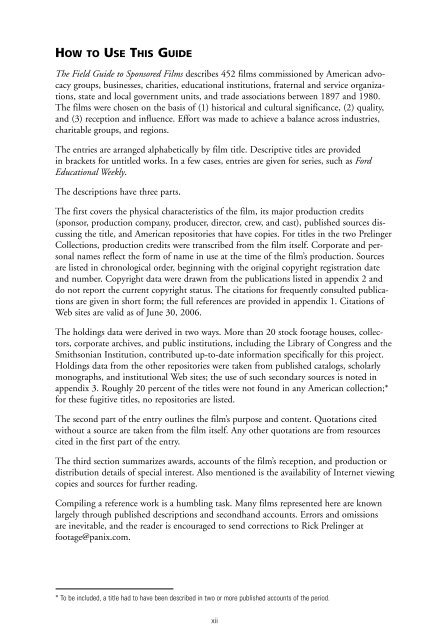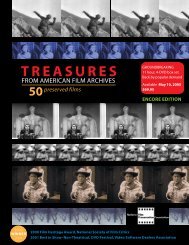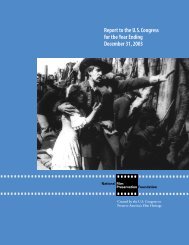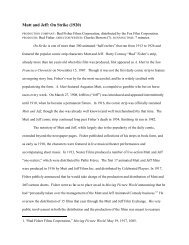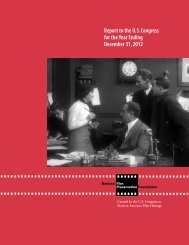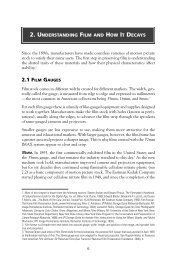Field Guide to Sponsored Films - National Film Preservation ...
Field Guide to Sponsored Films - National Film Preservation ...
Field Guide to Sponsored Films - National Film Preservation ...
Create successful ePaper yourself
Turn your PDF publications into a flip-book with our unique Google optimized e-Paper software.
HOW TO USE THIS GUIDE<br />
The <strong>Field</strong> <strong>Guide</strong> <strong>to</strong> <strong>Sponsored</strong> <strong><strong>Film</strong>s</strong> describes 452 films commissioned by American advocacy<br />
groups, businesses, charities, educational institutions, fraternal and service organizations,<br />
state and local government units, and trade associations between 1897 and 1980.<br />
The films were chosen on the basis of (1) his<strong>to</strong>rical and cultural significance, (2) quality,<br />
and (3) reception and influence. Effort was made <strong>to</strong> achieve a balance across industries,<br />
charitable groups, and regions.<br />
The entries are arranged alphabetically by film title. Descriptive titles are provided<br />
in brackets for untitled works. In a few cases, entries are given for series, such as Ford<br />
Educational Weekly.<br />
The descriptions have three parts.<br />
The first covers the physical characteristics of the film, its major production credits<br />
(sponsor, production company, producer, direc<strong>to</strong>r, crew, and cast), published sources discussing<br />
the title, and American reposi<strong>to</strong>ries that have copies. For titles in the two Prelinger<br />
Collections, production credits were transcribed from the film itself. Corporate and personal<br />
names reflect the form of name in use at the time of the film’s production. Sources<br />
are listed in chronological order, beginning with the original copyright registration date<br />
and number. Copyright data were drawn from the publications listed in appendix 2 and<br />
do not report the current copyright status. The citations for frequently consulted publications<br />
are given in short form; the full references are provided in appendix 1. Citations of<br />
Web sites are valid as of June 30, 2006.<br />
The holdings data were derived in two ways. More than 20 s<strong>to</strong>ck footage houses, collec<strong>to</strong>rs,<br />
corporate archives, and public institutions, including the Library of Congress and the<br />
Smithsonian Institution, contributed up-<strong>to</strong>-date information specifically for this project.<br />
Holdings data from the other reposi<strong>to</strong>ries were taken from published catalogs, scholarly<br />
monographs, and institutional Web sites; the use of such secondary sources is noted in<br />
appendix 3. Roughly 20 percent of the titles were not found in any American collection;*<br />
for these fugitive titles, no reposi<strong>to</strong>ries are listed.<br />
The second part of the entry outlines the film’s purpose and content. Quotations cited<br />
without a source are taken from the film itself. Any other quotations are from resources<br />
cited in the first part of the entry.<br />
The third section summarizes awards, accounts of the film’s reception, and production or<br />
distribution details of special interest. Also mentioned is the availability of Internet viewing<br />
copies and sources for further reading.<br />
Compiling a reference work is a humbling task. Many films represented here are known<br />
largely through published descriptions and secondhand accounts. Errors and omissions<br />
are inevitable, and the reader is encouraged <strong>to</strong> send corrections <strong>to</strong> Rick Prelinger at<br />
footage@panix.com.<br />
* To be included, a title had <strong>to</strong> have been described in two or more published accounts of the period.<br />
xii


